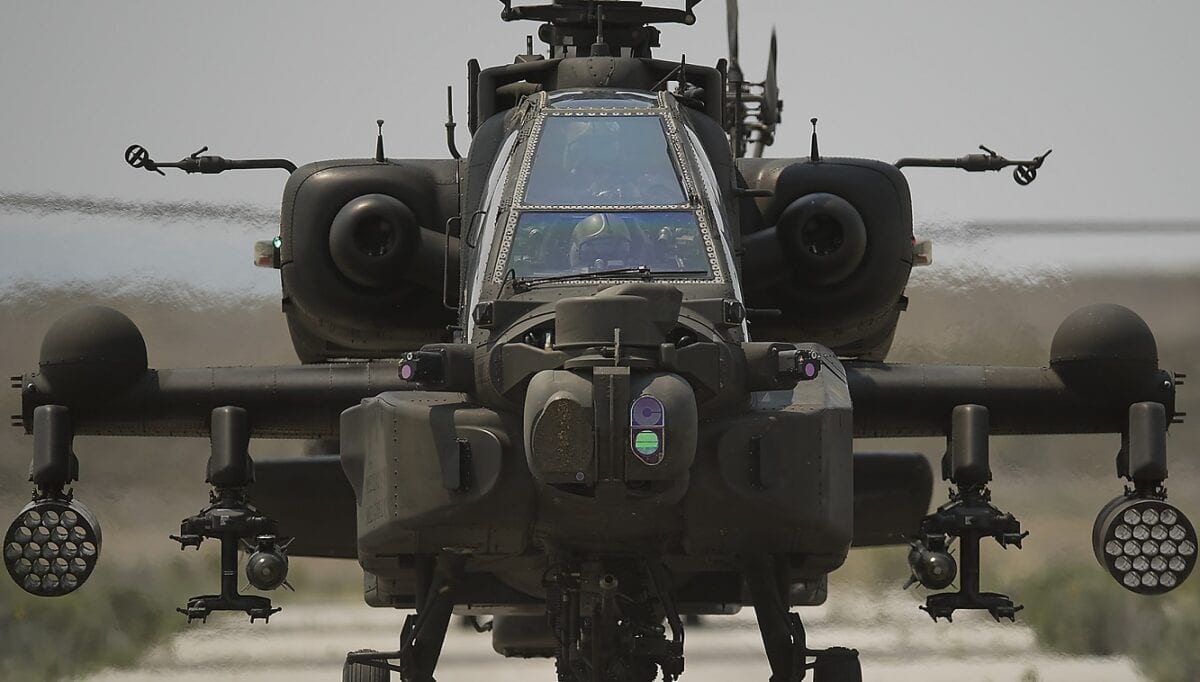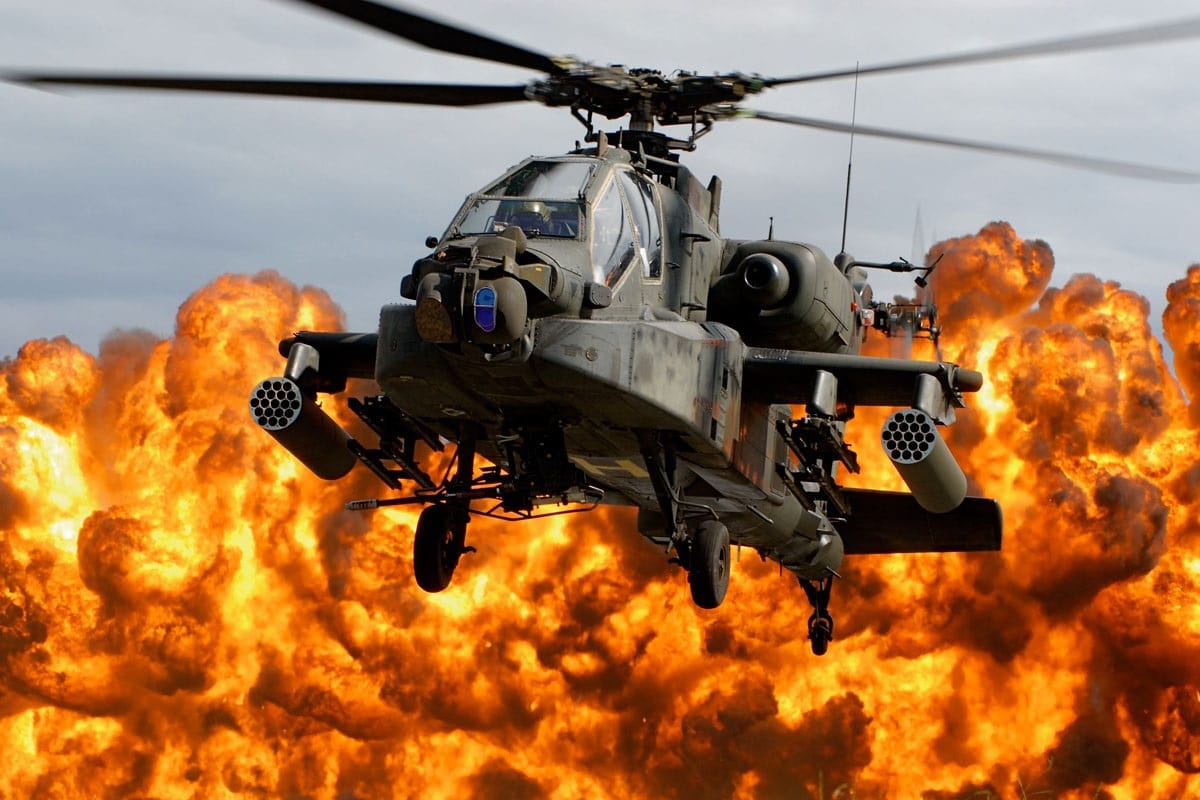Consistent with the US Army tradition of naming helicopters after Native American tribes, the Boeing AH-64 was named for the Apache tribe, a group of nomads, known as expert horse riders dependent upon the buffalo for survival. The AH-64 is perhaps the world’s preeminent attack helicopter, a tech marvel loaded with advanced weaponry, an important tenet of the US Army forces.
The most revolutionary aspect of the Apache is not outwardly obvious; it’s not the helicopter’s appearance or performance envelope. Rather, what separates the Apache from other helicopters is the Integrated Helmet and Display Sighting System (IHADSS) that both the pilot and gunner wear. The IHADSS, as you may have guessed from the name, is a helmet with an attached monocle. Remarkably, the monocle is able to track the wearer’s eye movements, allowing the wearer to operate the system simply through moving his or her eye.
One example: the IHADSS synchronizes the wearer’s eye movements to the movements of the AH-64s M230 Chain Gun. The result: when the wearer moves their eye, or locks on a target with their eye, the M230 moves, or locks on a target. Target acquisition is as simple as looking through an eyepiece.
IHADSS relies heavily upon the Target Acquisition and Designation System (TADS), which mounts to the front of the Apache. The TADS is a bulbous electro-optical sensor and laser target designator with a thermographic camera and monochrome daylight television camera onboard.
The combination of the IHADSS and TADS, plus additional onboard sensors, allows the Apache to operate on the front lines, in adverse weather conditions, in the day or night. For nighttime operations, the Apache is equipped with the Pilot Night Vision System (PNVS) that allows operators to see in the dark – an advantage enemies rarely enjoy. The Apache also uses passive infrared countermeasures, GPS, and the Ground Fire Acquisition Systems (GFAS) – a two sensor system that uses a thermographic camera to detect – and then target – ground-based weapons fire; the GFAS can detect muzzle flashes, or small arms fire, in any light condition in a 120-degree field of vision. The net effect of the Apache’s myriad sensors and gadgets is the ability to target as many as 256 targets, in a 31-mile radius, at the same time.
With so many onboard systems, the Apache can be recalibrated to perform a variety of mission profiles – everything from Anti-Armor missions, to Covering Force, to Escort. No matter the mission profile, the Apache carries 1,200 30mm rounds for the IHADSS-synced M230 Chain Gun. The Apache can also be outfitted with varying combinations of Hellfire missiles and Hydra 70mm rockets.
The Apache first entered service with the US Army in 1986, in time to participate during Operation Just Cause, the US invasion of Panama. But the Apache’s first significant test was Operation Desert Storm, the 1991 invasion of Iraq – a conflict that Apache’s actually served to start, when they conducted a secret, night raid against Iraq’s radar network on January 17, 1991. By the end of Desert Storm, the Apache had racked up 278 Iraqi tank kills – but the Apache was plagued with logistical and maintenance issues. Accordingly, the Apache was often grounded and only flew in one-fifth of the flight-hours the Apache had originally been planned to fly.
The Apache has gone on to serve in America’s 21st century conflicts, again in Iraq, and for two full decades in Afghanistan. The Apache has also been exported to allies around the world. Israel, the Netherlands, Japan, the UK, and South Korea all use the AH-64.

Modernized Apache Helicopter. Image Credit: Boeing.

The second AH-64 Apache rolls onto the taxiway and to the takeoff pad.
The Idaho Army National Guard’s Orchard Combat Training Center was host to elements of the Republic of Singapore Air Force during July. Based in Arizona, The Singapore contingent operates eight AH-64 Apache Helicopters as part of the Peace Vanguard Task Force.
The Apache is an attack helicopter with a tandem cockpit for a crew of two. It features a nose-mounted sensor for target acquisition and night vision systems. It is armed with a 30 mm M230 chain gun. It also features four hardpoints mounted on stub-wing pylons for carrying armament, typically a mixture of AGM-114 Hellfire missiles and Hydra 70 rocket pods. The Apache’s first flight took place in 1975 and was formally introduced into the U.S. Army in 1986.
MORE: Why Putin Fears the M1 Abrams Tank
MORE: I Went to War in the Leopard 2 Tank Ukraine Wants
Harrison Kass is the Senior Defense Editor at 19FortyFive. An attorney, pilot, guitarist, and minor pro hockey player, he joined the US Air Force as a Pilot Trainee but was medically discharged. Harrison holds a BA from Lake Forest College, a JD from the University of Oregon, and an MA from New York University. He lives in Oregon and listens to Dokken. Follow him on Twitter @harrison_kass.

